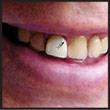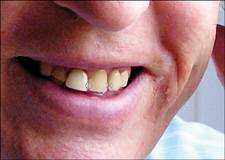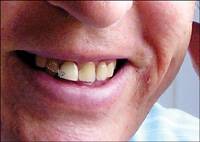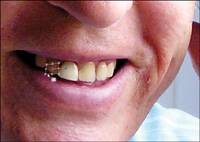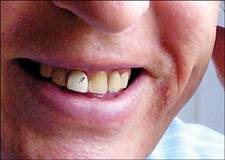Project4.Brighter, Whiter Teeth
Project 4. Brighter, Whiter TeethHave you ever taken pictures of people who refuse to smile? No matter how much you beg and cajole, you just can't get them to show their pearly whites. In most cases, it's because their whites aren't that pearly. More people are ashamed of their teeth than almost any other body part, and although there seems to be no end to the teeth whitening commercials on TV these days, those products don't do the job for everyone. You can reassure your friends that their smiles will be at their best if you learn how to do some digital dental work. The best part is that there's no messy gel or mouthpiece, and instead of waiting weeks to see results, your friends and family can display their brilliant smiles in just minutes, at least in photo form. For this project, I'm using the same businessman we de-wrinkled earlier in this chapter. His face is much smoother, but that only serves to make the yellow of his teeth stand out that much more (see Figure 2.22). In a few steps, he can have a younger smile to match his digital dermabrasion. Figure 2.22. Too much coffee. Note When we finished the last project with this image, we used the Opacity setting of the top layer to allow a hint of the background layer to show through. Although this suited our purposes for that project, it can work against us here. If you whiten the teeth on the bottom layer, residual yellowing will remain because of the un-retouched layer above it. If you whiten the teeth on the topmost layer, further adjustments to the Opacity setting will allow the yellowing from the background layer to reappear. The key to avoiding these problems is to be sure you're happy with your Opacity settings before beginning the teeth whitening process. Then, with the top layer active, select Layers, Merge, Merge Down. This flattens the image back down to one layer, with all your changes incorporated.
A Little OrthodontiaIf you look closely at the mouth, you'll notice that one of the teeth is a bit crooked and more prominent than the others. If you want to remain true to your subject, leave this alone. To present him at his best, however, the digital equivalent of braces is in order. There are actually two problems with the prominent tooth. First, the bottom-right corner overlaps the tooth next to it a bit. Let's start there.
A Bit Longer in the ToothNow let's look at the left side of the prominent tooth. Even though that tooth appears larger, the bigger problem is that the tooth to the left of it is smaller than its counterpart on the other side of the mouth. We can use this flaw to our advantage. If we lengthen the smaller tooth a bit, it will even things out.
None of these changes have been drasticalthough you could certainly make them as outrageous as you want. Even a little bit of cosmetic work has improved the smile, however, and has us ready for the next step (see Figure 2.26). Figure 2.26. Orthodontia complete...now onto the whitening. Whitening Without the MessAfter all this prep work, the actual whitening process is easy. There are several digital approaches to tooth whitening, ranging from the relatively simple to the extremely complex. Paint Shop Pro X has made it downright easy, though, with the Makeover tool.
A Step Further...or NotAs you can see from the end result (see Figure 2.28), our businessman now has a whiter smile to go with his softer skin. We could have gone further in our digital orthodontia and narrowed the prominent tooth even further, but I don't like to completely remove someone's imperfections. If everyone started looking the same, the world would become very boring visually. Figure 2.28. Ready for his close-up.
The Makeover tool greatly simplifies tooth whitening, but it comes at a price: The tool limits your control over the process because it guesses which area you intend to whiten and how much whitening to apply. You can mitigate this somewhat with judicious use of the Strength setting, but you're still compromising ultimate power for ease of use. For those with the time and inclination, the old-fashioned approaches to digital dentistry are often worth the effort. For one such method, select the teeth, without capturing the lips and gums; then feather the selection (Selections, Modify, Feather) by 1 pixel. Select Adjust, Hue and Saturation, Hue/Saturation/Lightness; set the Saturation to 0; and then bump up the Lightness until you get the desired shade. Another technique involves selecting the teeth and using the Dodge brush to whiten the teeth. It's your digital darkroom, so use the technique that gives you the best results! |
EAN: 2147483647
Pages: 109
